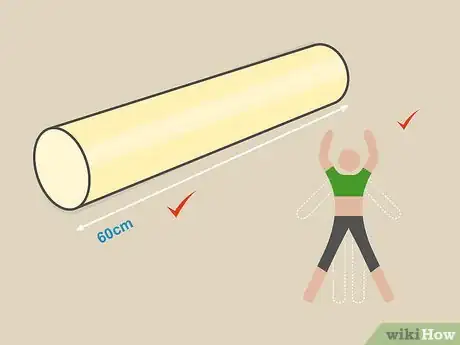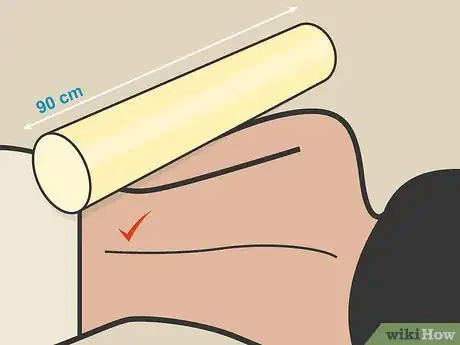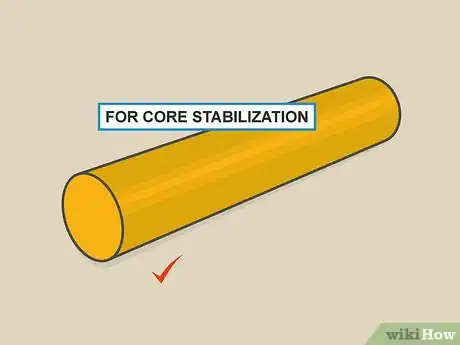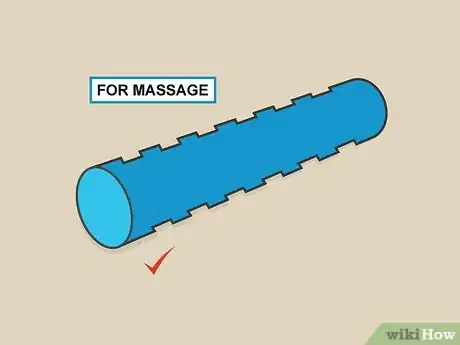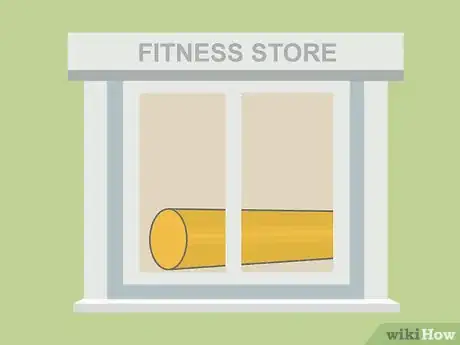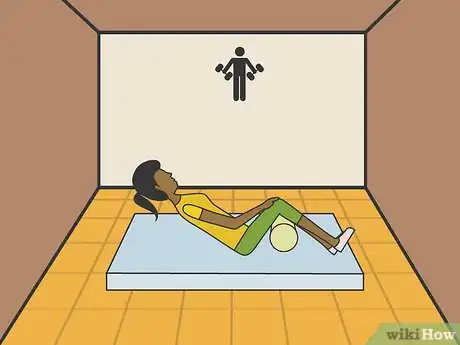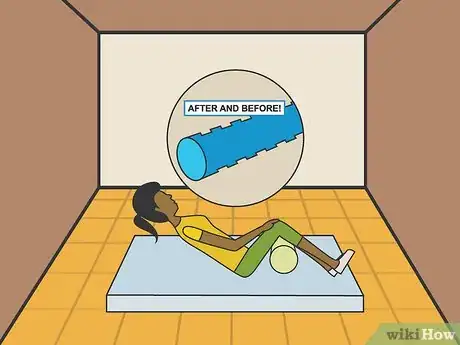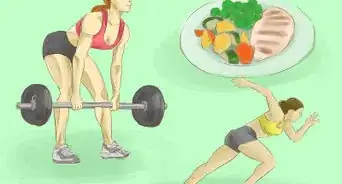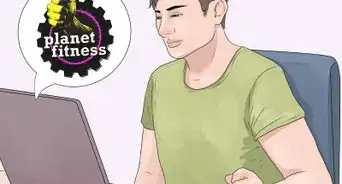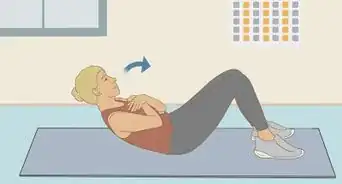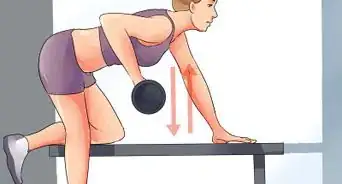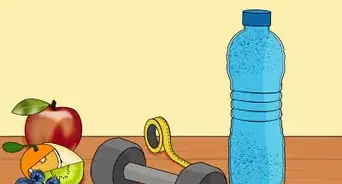This article was co-authored by Julian Arana, M.S.eD., NCSF-CPT. Julian Arana is a Personal Trainer and the Founder of B-Fit Training Studios, a personal training and wellness set of studios based in Miami, Florida. Julian has over 12 years of personal training and coaching experience. He is a certified personal trainer (CPT) by the National Council on Strength and Fitness (NCSF). He has a BS in Exercise Physiology from Florida International University and an MS in Exercise Physiology specializing in strength and conditioning from the University of Miami.
wikiHow marks an article as reader-approved once it receives enough positive feedback. In this case, several readers have written to tell us that this article was helpful to them, earning it our reader-approved status.
This article has been viewed 503,694 times.
Foam rolling is a form of self-myofascial release (SMR) that targets tense and overworked muscles. With the pressure created by your own body weight, you can use a foam roller on the back, hips, legs, arms, as well as other parts of the body to release muscle knots. A foam roller can also help increase balance and core stability. Foam rollers differ in size, shape, foam type, construction, and cost. By determining your specific uses for the foam roller, you can buy a foam roller that fits your needs to achieve the best result.
Steps
Choosing the Right Size
-
1Choose a 3 to 4 inch (7.6 to 10.2 cm) diameter for a targeted approach. Most foam rollers have a 6-inch (15 cm) diameter, but a roller with a smaller diameter can be helpful for targeting certain parts of the body. For example, a thinner foam roller can target shoulder muscles better than a larger roller would.
- Foam rollers with a smaller diameter are also helpful for elderly patients who need to be closer to the ground for stability.
-
2Use a half-round foam roller if you have issues with strength. Half-round foam rollers are a good choice for an elderly person or someone with little strength or muscle tone. When laid with the flat side down, the roller will not move easily out from under them. Simply laying on a half-round roller in the area of tight muscles can release tension. The user can also move back and forth slightly as they grow comfortable with the roller.[1]Advertisement
-
3Choose a 12-inch (30 cm) roller if you will travel with it. Select a 12-inch (30 cm) round roller if you intend to transport your roller often. For example, you may want to bring it to a Pilates class and use it at home. 12-inch rollers are also useful if you are working out in a small space.[2]
-
4Get a 24-inch foam roller for your arms and legs. A 24-inch foam roller is ideal for parts of your body that aren’t typically very wide. This foam roller size would be ideal for your legs and arms, but may be too short for rolling out your back.
-
5Pick a 36-inch (90 cm) foam roller if you intend to use it on your back. A long foam roller will allow you to roll with it perpendicular to your back, without fear of falling off the ends. A 36-inch roller is usually the longest available, but you may be able to find a longer roller online if it is needed.
Picking the Appropriate Density
-
1Pick a white foam roller if you are a beginner. Base how firm your roller is on your experience level with rolling.[3] A white foam roller is great for beginners because it will produce less pressure and less pain. White foam rollers are often made of a piece of polyethylene foam and are the least dense, so they will allow some movement between the muscles, bones, and the roller.[4]
- Foam rolling can be painful at the beginning because you push on your muscles with your full body weight.
- White foam rollers cost less because of the lower density of the foam.
- A white foam roller is also a good choice if you plan to use it for exercise.
-
2Go for a medium foam roller for core-stabilization. A medium, light colored roller will also provide a medium amount of massage pressure. These blue or green foam rollers are often made of closed cell polyethylene foam or EVA foam, and they are common in Pilates classes.[5]
-
3Choose an EVA foam roller for moderate firmness and durability. EVA foam rollers are becoming more popular. They are often green. EVA rollers are moderately firm and offer a more comfortable surface that is warm to the touch. They are advertised as being more durable than polyethylene foam rollers but will likely cost up to $45 (31 euros or 27 dollars). [6]
-
4Pick a black foam roller if you are experienced. This is also a good roller to choose if you desire hard pressure for self-massage. Although most black foam rollers are also made of polyethylene foam, they are closed cell and manufactured under high heat, making them smoother, denser, and less porous.[7]
-
5Choose a roller with a dimpled appearance for a deeper massage. A foam roller with a dimpled surface will give a deeper massage to trigger points in the muscles. This type of roller is great for parts of the body that are prone to muscle tightness, like the back and shoulders. A dimpled roller, however, may be painful if you are not used to a deep and focused massage. [8]
Using a Foam Roller
-
1Ask your doctor for help with choosing and using a roller. If you aren’t sure which type of foam roller is ideal for you, ask your doctor or physical therapist. A doctor can determine what your primary use of the foam roller will be, and help you choose the best roller for you. Your doctor will also be able to show you how to use a foam roller in a way that is safe and helpful for you.
- You can also ask your doctor if they recommend a brand or store to buy the roller from.
-
2Buy a foam roller from your local fitness store or online. A fitness store is the most common place to purchase a foam roller. Visit the store or call ahead to make sure they have the type of foam roller you’re looking for. It’s also an option to order the foam roller online, as long as you purchase it from a reputable source.[9]
- If you don’t have a fitness store in your area, some supermarkets with a workout section, like Walmart, will have foam rollers.
-
3Learn to use your roller at your gym. Outside of physical therapy, most people learn to do foam rolling through a class or a personal trainer. These classes introduce techniques that can help you make the most of your foam roller and give you exercises to use with your roller. Many gyms will provide a foam roller during the session if you do not yet have your own.
-
4Use it for tissue massage. Foam rollers aren’t only used by those engaged in physical activity. Rollers are great for releasing tension in the muscles. For example, if you have to stand on your feet all day at work, use a foam roller to relax the resulting muscle knots.[10]
- A foam roller is also great for releasing muscles that are persistently stiff from a prior injury.
-
5Buy a foam roller to use before and after exercise. A foam roller may help prepare your muscles for an intense workout.[11] Rolling out your muscles will improve blood flow and help stretch out the muscles. Giving yourself a deep tissue massage with the foam roller will also help recovery time after a workout.
- A dominant could also be for exercises like balance and core training during your workout.
-
6Figure out if you can handle using a foam roller. A foam roller has many helpful uses, but it is not for everyone. The deep tissue massage a roller provides can feel painful, especially to those with very stiff muscles. If you do experience pain while using the foam roller, stop using it until you can consult a doctor.[12]
Expert Q&A
Did you know you can get expert answers for this article?
Unlock expert answers by supporting wikiHow
-
QuestionWhat is the best foam roller for beginners?
 Julian Arana, M.S.eD., NCSF-CPTJulian Arana is a Personal Trainer and the Founder of B-Fit Training Studios, a personal training and wellness set of studios based in Miami, Florida. Julian has over 12 years of personal training and coaching experience. He is a certified personal trainer (CPT) by the National Council on Strength and Fitness (NCSF). He has a BS in Exercise Physiology from Florida International University and an MS in Exercise Physiology specializing in strength and conditioning from the University of Miami.
Julian Arana, M.S.eD., NCSF-CPTJulian Arana is a Personal Trainer and the Founder of B-Fit Training Studios, a personal training and wellness set of studios based in Miami, Florida. Julian has over 12 years of personal training and coaching experience. He is a certified personal trainer (CPT) by the National Council on Strength and Fitness (NCSF). He has a BS in Exercise Physiology from Florida International University and an MS in Exercise Physiology specializing in strength and conditioning from the University of Miami.
Certified Personal Trainer
-
QuestionOnce purchased, is there any reason to replace a foam roller unless it physically breaks?
 Michele DolanMichele Dolan is a BCRPA certified Personal Trainer in British Columbia. She has been a personal trainer and fitness instructor since 2002.
Michele DolanMichele Dolan is a BCRPA certified Personal Trainer in British Columbia. She has been a personal trainer and fitness instructor since 2002.
Certified Fitness Trainer
-
QuestionWhat is the best size foam roller?
 Michele DolanMichele Dolan is a BCRPA certified Personal Trainer in British Columbia. She has been a personal trainer and fitness instructor since 2002.
Michele DolanMichele Dolan is a BCRPA certified Personal Trainer in British Columbia. She has been a personal trainer and fitness instructor since 2002.
Certified Fitness Trainer
Warnings
- Be careful when using a foam roller if you have skin conditions or hyper-mobile joints. The rolling motion can exacerbate skin conditions, and people with movable joints can be easily injured if they use a foam roller over those joints.⧼thumbs_response⧽
- People with balance or vertigo issues should not use foam rollers, as it can be harmful to the condition.⧼thumbs_response⧽
- Avoid using the foam roller on your lower back, using it too fast, or focusing too long on one spot. Stop rolling immediately if you experience spasms or pain.⧼thumbs_response⧽
References
- ↑ http://heavy.com/tech/2015/04/best-foam-rollers-fitness-running-massage/
- ↑ https://connect.uclahealth.org/2018/06/12/facts-about-foam-rollers-may-entice-you-to-try-one/
- ↑ Julian Arana, M.S.eD., NCSF-CPT. Certified Personal Trainer. Expert Interview. 19 May 2020.
- ↑ https://greatist.com/fitness/how-choose-the-right-foam-roller
- ↑ https://greatist.com/fitness/how-choose-the-right-foam-roller
- ↑ https://greatist.com/fitness/how-choose-the-right-foam-roller
- ↑ http://heavy.com/tech/2015/04/best-foam-rollers-fitness-running-massage/
- ↑ https://greatist.com/fitness/how-choose-the-right-foam-roller
- ↑ http://heavy.com/tech/2015/04/best-foam-rollers-fitness-running-massage/
- ↑ https://greatist.com/fitness/how-choose-the-right-foam-roller
- ↑ Julian Arana, M.S.eD., NCSF-CPT. Certified Personal Trainer. Expert Interview. 19 May 2020.
- ↑ https://greatist.com/fitness/how-choose-the-right-foam-roller
About This Article
To choose a foam roller for a beginner, pick a white foam roller, which is softer and produces less pressure. For a more experienced user, go with a smoother, denser black roller. Next, decide between a small diameter roller for targeting small areas, like your shoulders, or a wider diameter roller for rolling along your back or legs. Alternatively, consider getting a half-round foam roller if you have issues with strength, since it can’t easily roll out from under you. For more advice from our Fitness reviewer on how to use a foam roller to release muscle tension, read on!



